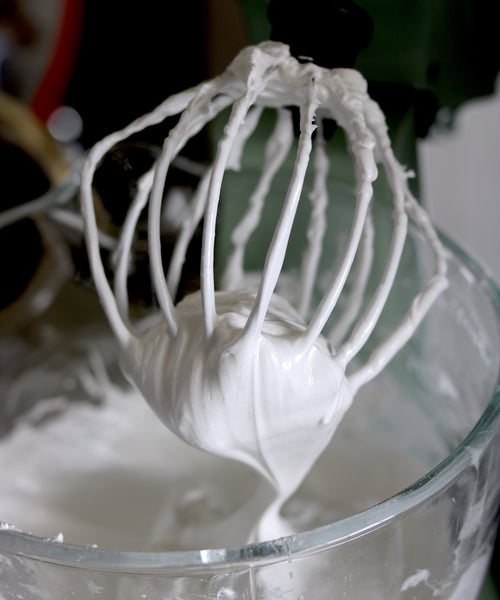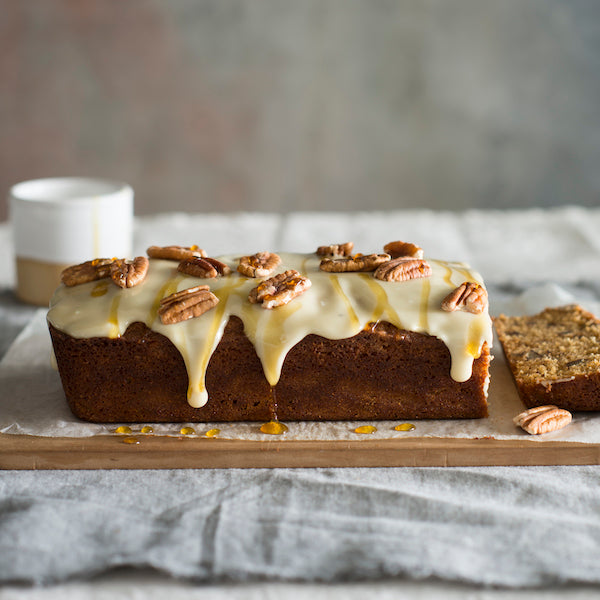BakeClub Blog

Which type of meringue should I use?
Meringue is a simple combination of whisked egg whites and sugar, but it is the technique used to bring them together that determines the type of meringue you end up with. Here we look at the three main types (Swiss, French & Italian), how to make them and when they are best used.
French (Simple) Meringue
This is the most common and easiest to make of the meringues and is known as an ‘uncooked’ meringue. Egg whites are whisked until soft peaks form. The sugar is then gradually whisked in, a large spoonful at a time, until fully incorporated and it has dissolved. Sometimes a separate portion of icing sugar is folded through the mixture after the caster sugar has been incorporated.
Generally 55g (¼ cup/2oz) caster or icing sugar is used for to every white from a 60g (2oz) egg to create a French meringue that is to be baked on its own. French meringue made with less sugar is often used to lighten base mixtures such as in a chiffon cake and or flourless cake.
French meringue is the least stable of the three meringue types but the lightest and the most airy.
It is often used for making individual meringues,
pavlovas, and torte layers with the addition of ground nuts. It is also the type of meringue used to make oeufs a la neige (snow eggs) and sweet soufflés.
Swiss Meringue
With this type of meringue, the egg whites and sugar
are heated gently together in a double saucepan over simmering water until the sugar dissolves and the mixture reaches a particular temperature (usually between 50-70°C/122-158°F). The mixture is then whisked until cooled to room temperature.
The higher the temperature that the egg white and sugar mixture is heated to before whisking, the more concentrated the sugar content will be (as moisture evaporates as the temperature increases) and the more ‘sticky’ the final meringue mixture will become.
It is important that the water below doesn’t touch the bowl with the egg whites and sugar and that the water is kept at a bare simmer. If the heat becomes too intense it will cause the egg whites to set, therefore affecting the texture of the final meringue. It is also important to whisk the mixture until cooled to room temperature or the meringue will have little body and won’t hold its shape when piped or spooned onto trays.
Because the sugar is added right at the beginning with this method the egg whites are prevented from increasing in volume as much as the other meringue methods and can be slightly denser in texture. It is however, a more fragile meringue than Italian.
Swiss meringue is ideal for piping, as it holds its shape well, and incorporating with other mixtures
or ingredients, as it also retains its volume. Swiss meringue can also be made into a silky smooth Swiss meringue buttercream.
Italian Meringue
Italian meringue is made with a sugar syrup. The egg whites are first whisked to soft peaks and then a hot sugar syrup (that has been boiled to soft ball stage, 115°C/240°C) is gradually added while whisking. Once all the sugar syrup has been added the mixture is then whisked until it cools to room temperature, becomes glossy and stiff peaks form when the whisk is lifted. It must be made with an electric mixer and it has a close texture with a thick, silky, smooth consistency.
The hot syrup partially cooks the whites so that the resulting meringue mixture is more stable than the other two types of meringue. For this reason, it is often used in recipes that requires meringue toppings that aren’t baked, or are only partially baked (or torched) to colour it, such as with a Lemon Meringue Pie or Baked Alaska. However, it can still be baked like a French meringue and results in a very crisp meringue.
Like Swiss meringue, Italian meringue is ideal for piping as it holds its shape well. It also holds its volume well when combined with other mixtures
or ingredients.








